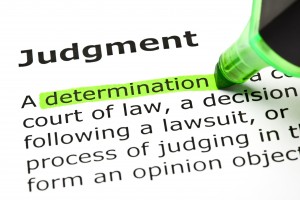By Ryan C. Wood
The issue here is who must be served when filing a motion to avoid a judicial lien under Section 522 or 506 of the Bankruptcy Code. There could be a number of parties involved or a number of attorneys involved in obtaining and enforcing the judicial lien before a bankruptcy case is filed. So who has to be served with the motion to value or avoid the lien? Is service required on the state court attorney that obtained the judgment, the original creditor or the potential attorney now representing the creditor in the bankruptcy case?
FRBP 9014 and 7004
Once the bankruptcy case is filed the Federal Rules of Bankruptcy Procedure, Federal Rules of Procedure and local bankruptcy rules take over. All states have laws governing the enforcement and collection of lien rights and judicial lien rights. Procedures for contested matters in bankruptcy cases are governed by Federal Rule of Bankruptcy Procedure 9014, which requires service of a motion “in the manner provided for service of a summons and complaint by Rule 7004 . . . .” Rule 9014(a). So we have to look to FRBP 7004. Service of a summons and complaint varies depending upon the type of entity the creditor is. Whether the creditor is a sole proprietorship, limited liability company, corporation or is insured depository institution. If FDIC insured service shall be made by certified mail addressed to an officer of the institution unless— (1) the institution has appeared by its attorney, in which case the attorney shall be served by first-class mail; (2) the court orders otherwise after service upon the institution of notice of an application to permit service on the institution by first-class mail sent to an officer of the institution designated by the institution; or (3) the institution has waived in writing its entitlement to service by certified mail by designating an officer to receive service.
Ninth Circuit Bankruptcy Appellate Panel Case
In a recent 9th Cir. BAP case; Teresa Bryant, Appellant, vs. The Bank of New York Mellon; Select Portfolio Servicing, BAP No. CC-16-1009-DKuF, discussed the proper service of a motion to avoid a judicial lien. In this case Ms. Bryant’s bankruptcy attorney served the motion by certified mail on a bank officer of Mellon pursuant to FRBP 7004 and served each attorney that appeared on behalf of Mellon in the bankruptcy case. In the Northern District of California we have a local rule that says if a claim was filed for the lien, then the address provided on the claim has to be served in addition to the requirements of FRBP 7004 be met. Mellon tried to argue that since their state court attorney was not served the motion to value service was defective. This issue was addressed in Frates v. Wells Fargo Bank, N.A. (In re Frates), 507 B.R. 298, 301 (9th Cir. BAP 2014). The appellee bank in Frates argued their state court attorney should have been served with the motion to value or avoid. The Ninth Circuit BAP said no.
The Ninth Circuit Bankruptcy Appellate Panel previously concluded that compliance with Rule 7004(h) was all that was required. The court recognized that California law would have required service of post-judgment motions on the state court attorney, but the court did not “perceive any reason why compliance with California law should be compelled in light of the procedural due process safeguards provided by the rules themselves. This means that when enforcing the judicial lien under California law post-judgment motions must be served on the state court attorney for the judgment creditor. That is not the case after a bankruptcy case is filed.
You Do Not Have To Serve The State Court Attorney
Bankruptcy case rules make no mention of serving a motion to avoid a judicial lien on any state court attorney involved in the matter previously. In the Bryant appeal the debtor’s bankruptcy attorney served the attorney that made an appearance for Mellon and filed a motion for relief from stay filed in the bankruptcy case and still served an officer of Mellon by certified mail. The Ninth Circuit Bankruptcy Appellate Panel held nothing more was required. The lower bankruptcy court unfortunately evaluated the circumstances of not serving the state court attorney as a possible fraud on the bankruptcy court for not serving Mellon’s state court attorney with the motion to value. The 9th Circuit Bankruptcy Appellate Panel decidedly said no. There was no fraud on the bankruptcy court.
What Creditors Attorneys Should Do
If a state court attorney wants to be noticed or a creditor wants their state court attorney that obtained the judgment to be served then the state court attorney should file a request for special notice in the bankruptcy case. Then they have to be provided notice. In Chapter 7 bankruptcy cases judicial liens can be avoided in no assets cases. In a no asset case there is no call for creditors to file claims or even make an appearance in the case at all. Under these circumstances no attorney will make an appearance for a creditor in the Chapter 7 no asset bankruptcy case. The only viable service is pursuant to FRBP 9014 and 7004. In Chapter 13 bankruptcy cases claims are called to be filed on behalf of creditors. So in theory in a Chapter 13 case there could be an attorney or other party to provide notice to and meet the requirements of FRBP 7004.
